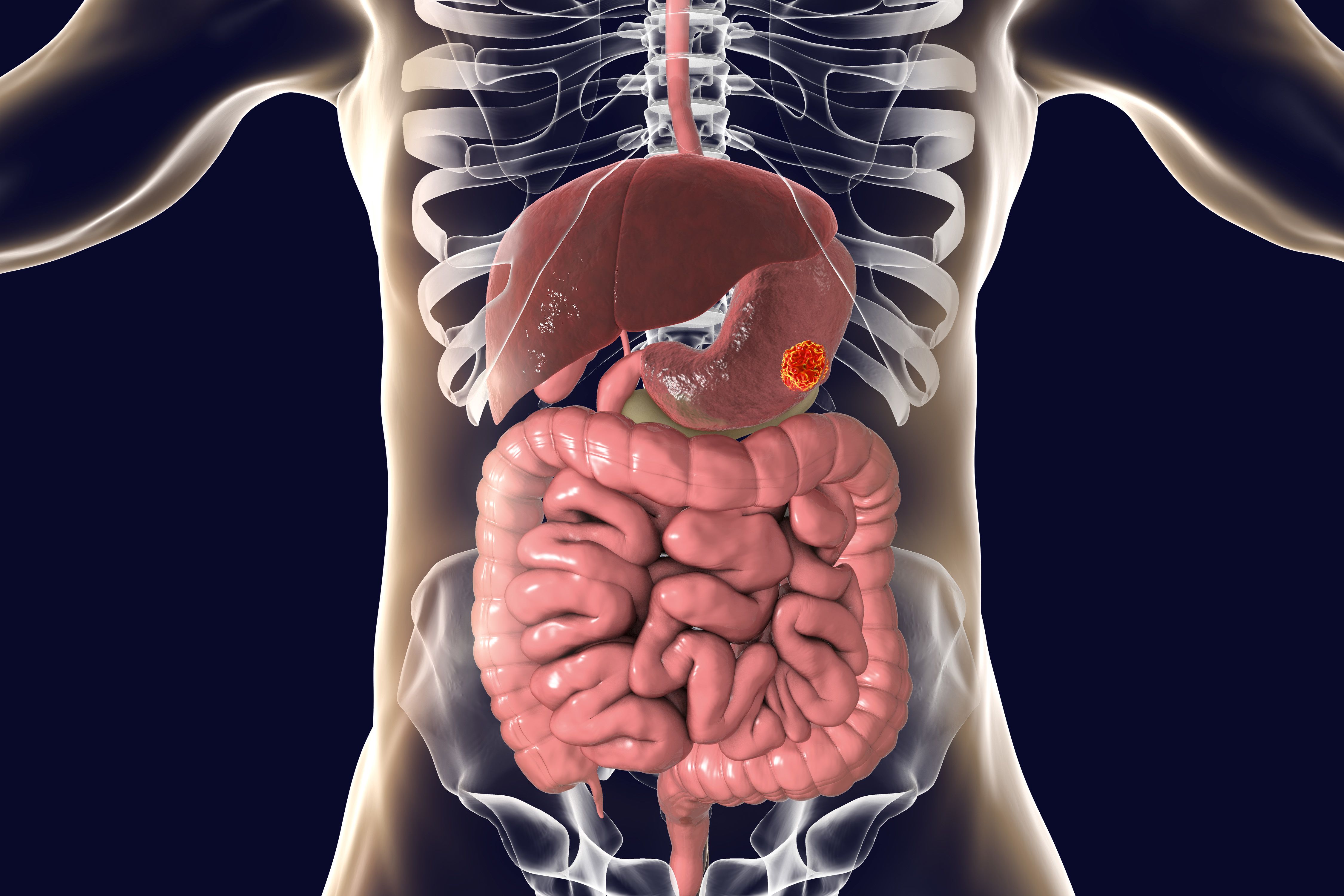Novel Combination Mitigates Chemo-Induced Myelosuppression in Gastric/GEJ Cancer
SHR-1701 plus CAPOX chemotherapy reduced treatment delays and dose reductions compared with placebo plus CAPOX in HER2-negative gastric/GEJ cancer.
SHR-1701 plus CAPOX reduces treatment disruptions in HER2-negative gastric/GEJ cancer.

The bifunctional PD-L1/TGF-β inhibitor SHR-1701, in combination with chemotherapy, reduced chemotherapy-associated myelosuppression in patients with HER2-negative gastric/gastroesophageal junction adenocarcinoma (GEJ), according to results from a multicenter, 2-part phase 3 trial (NCT04950322).1
Findings from the study were presented at the 2025 ASCO Gastrointestinal Cancer Symposium.
At the data cutoff of May 20, 2024, the median treatment exposure for patients in the combination group for SHR-1701, capecitabine, and oxaliplatin (CAPOX) were 137.0 days (range, 65.5-251.5), 122.0 days (83.0-138.0), and 107.0 days (66.0-123.0), respectively. In the placebo/CAPOX group, median treatment exposure for placebo, capecitabine, and oxaliplatin was 127.5 days (62.0-190.0), 122.0 days (73.5-135.0), and 108.5 days (64.0-121.0).
Median treatment cycles for the SHR-1701/CAPOX group for SHR-1701, capecitabine, and oxaliplatin were 7 (IQR, 4-11), 6 (4-6), and 6 (4-6), respectively; for the placebo/CAPOX group median treatment cycles for placebo, capecitabine, and oxaliplatin were 6 (4-9), 6 (4-6), and 6 (4-6), respectively.
Median relative dose intensity for the SHR-1701/CAPOX group for SHR-1701, capecitabine, and oxaliplatin was 94.5%, 83.4%, and 91.1%, respectively; for the placebo/CAPOX group median treatment cycles for placebo, capecitabine, and oxaliplatin were 94.4%, 83.6%, and 90.6%.
Additionally, in the SHR-1701/CAPOX group and placebo/CAPOX group, treatment-related adverse events (TRAEs) leading to CAPOX delays were platelet count decreased (20.6% vs 32.0%), neutrophil count decreased (8.0% vs 11.7%), and white blood cell count decreased (7.1% vs 9.0%). TRAEs leading to CAPOX reductions in the SHR-1701/CAPOX and placebo/CAPOX groups were platelet count decreased (15.7% vs 17.8%), neutrophil count decreased (7.4% vs 10.1%), and white blood cell count decreased (1.9% vs 1.1%).
“SHR-1701 showed the capacity to suppress chemo-associated myelosuppression, as evidenced by: fewer chemo delays and dose reductions; lower frequency of any grade, grade 3 or higher, and serious treatment-related hematological toxicities, including decreased platelet count, decreased neutrophil count, and decreased [white blood cell] count,” lead study author Zhi Peng, MD, an associate professor at Beijing Cancer Hospital, Peking University, and principal investigator of the study wrote in the presentation.1
Patients were randomly assigned in a 1:1 ratio to 1 of 2 groups and received either 30 mg/kg of intravenous SHR-1701 (n = 364) or intravenous placebo (n = 366) given on day 1 every 3 weeks, both with CAPOX chemotherapy (1000 mg/m2 of oral capecitabine taken twice a day on days 1 to 14 every 3 weeks and 130 mg/m2 of intravenous oxaliplatin given on day 1 every 3 weeks). Randomization was stratified by PD-L1 expression status, ECOG performance status, and peritoneal metastasis status.
Eligibility criteria included being 18 years and older with HER2-negative, unresectable locally advanced or metastatic gastric/GEJ adenocarcinoma and no prior systemic treatment. Patients also had to have an ECOG performance status of 0 or 1 and at least 1 measurable lesion per RECIST v1.1.
Treatment-related decreased platelet counts of any grade occurred in 59.6% of the SHR-1701/CAPOX group and 68.3% of the placebo/CAPOX group (difference, –8.7%); of grade 3 or higher in 19.0% and 28.1%, respectively (difference, –9.1%); and of serious indication in 6.9% and 9.0%, respectively (difference, –2.1%).
Treatment-related decreased neutrophil count of any grade occurred in 44.8% of the SHR-1701/CAPOX group and 54.9% of the placebo/CAPOX group (difference, –10.1%); of grade 3 or higher in 12.1% and 16.4%, respectively (difference, –4.3%); and of serious indication in 0.5% and 0.8%, respectively (difference, –0.3%).
Treatment-related decreased white blood cell count of any grade occurred in 40.4% of the SHR-1701/CAPOX group and 51.6% of the placebo/CAPOX group (difference, –11.2%); of grade 3 or higher in 3.6% and 5.2%, respectively (difference, –1.6%); and of serious indication in 0.3% and 0.8%, respectively (difference, –0.5%).
Per the safety summary, in the SHR-1701/CAPOX group, 97.8% TRAEs of any grade occurred vs 98.4% in the placebo/CAPOX group; of grade 3 or higher occurred in 62.6% and 59.0%, respectively; serious TRAEs occurred in 34.9% and 24.0%; and serious TRAEs occurred in 34.9% and 24.0%. TRAEs led to discontinuation of study medication in 10.4% and 3.0%, respectively; SHR-1701/placebo was discontinued in 8.2% and 1.9%; CAPOX was discontinued in 4.4% of the SHR-1701/CAPOX group and 1.6% of the placebo/CAPOX group. TRAEs led to death in 1.9% and 1.1%, respectively.
Previously, the trial met its primary end point of superior overall survival for SHR-1701/CAPOX vs placebo/CAPOX for this population and for those with PD-L1 combine positive score of 5 or more and in the intent-to-treat population.
Reference
Peng Z, Wang J, Zhang Y, et al. Effect of SHR-1701 on chemotherapy (chemo)-induced myelosuppression: data from a phase 3 study in HER2-negative gastric/gastroesophageal junction adenocarcinoma (G/GEJA). J Clin Oncol. 2025;43(4):335 doi:10.1200/JCO.2025.43.4_suppl.335
Multidisciplinary Training of BiTE-Associated AEs Increases Safety in Outpatient Setting
April 13th 2025Authors noted that BiTEs have expanded the treatment paradigms for several types of solid tumors and blood cancers; however, toxicities associated with this class of agents have raised safety concerns.



